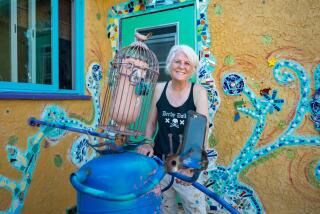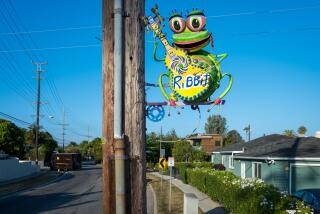ART : âWater Wallâ Competes With Nature--and Loses : Latest of Laguna public art offerings is ludicrously small and ill-suited to its ocean-side location at Surf & Sand hotel.
The Surf & Sand hotel in Laguna Beach recently unveiled âLaguna Water Wall,â a laminated glass sculpture by DeWain Valentine that represents the latest contribution to public art in the city of Pageant of the Masters fame. Valentine--a Southern California artist who made his mark with other âCool Schoolâ artists of the 1960s--is the biggest name the city has hauled in so far for its art program, which requires developers of a site to select a publicly accessible sculpture financed by 1% of construction costs.
But kindly hold your applause.
The sculpture in question is ludicrously small (about as big as a homey motel vacancy sign) and ill-suited to its ocean-side context. Plunked alongside the hotelâs semicircular driveway entrance, the piece is bland and irrelevant--a decoratorâs polite bauble, demurely surrounded by two small beds of pink flowers.
âLaguna Water Wallâ is a 6-foot-tall, 7-foot-wide translucent wedge of glass (clear on top, blue-green at the bottom) textured with vertical grooves. Sheets of water glide over the edge and plop into the surrounding shallow pool, lined with spotlights. If you look through the sculpture, you see a murky blur of blue sky and ocean, a glimpse of the surrounding patio and (clearest of all) the other side of the reflecting pool. It is not an especially appealing or transcendent vision.
On the other hand, if you walk past the sculpture and look over the railing to the ocean, you can catch one of the serenely lovely views people have traveled across the country to Southern California to gawk at. Who needs this glass thing, anyway?
The wimpy scale of the piece--which cost âin excess of $100,000,â according to a spokeswoman for the hotel--is particularly ironic, given Valentineâs essentially landscape-based sensibility. Endlessly intrigued with the evanescent quality of light, he fashioned wedges, discs and rings of cast polyester resin or acrylic plastic (sometimes uncolored, sometimes lightly tinted). They are at once solid three-dimensional objects and empty containers for light and space, minutely responsive to shifts in ambient lighting.
Valentine also was a pioneer in using industrial substances to make works of art, frequently on an out-sized scale (which makes the stunted size of the Laguna Beach piece all the more inexplicable). In 1976, he began making sculptures from laminated glass, which (unlike polyester) can withstand the rigors of outdoor locations.
Meanwhile, however, his cheering section has shifted from serious art publications in the 1960s and early â70s (Artforum, Arts) to glitzy shelter magazines and âgood lifeâ publications (Abitare, Palm Desert Life, Architectural Digest) in the later â70s and â80s. Except for the occasional exhibit of his older work, Valentine--in common with some of his peers who typified the Southern California art scene of the â60s and â70s--has been bypassed by the art world, while the decorator crowd has discovered him.
Valentineâs initial exploration of materials, light and space happened years ago; a new piece becomes little more than another certified art product for timid buyers looking to be admired for their good, safe taste. So it was not surprising to read in the press release that the James William Colachis family, owners of the hotel, made âa concerted four-month search . . . to find the perfect timeless, aesthetic statement.â
Timidity rarely saves the day when it comes to public art. Had Valentine really made a water wall --a physically imposing barrier obliging the viewer to see a huge swath of sky and ocean through it--the piece might have held its ground more forcefully against the lure of the ocean. If the wall had subtly filtered the view in a genuinely big-scale way, it might have suggested questions about the very concept of a âviewâ of nature: why the reality inevitably seems so much more and yet so much less than our mental picture.
Still, there really was no aesthetic reason to impose any work of art on this particular site. The basic issue is that a work of art can be upstaged by a pretty view quicker than a great actor by a precocious child. Unless the thrill or pleasure or discovery we get from looking at a sculpture in front of the ocean adds something to our naive pleasure at simply seeing the ocean--why not forget the art and leave the view?
In Newport Beach, the city wisely came to that conclusion when it hired Cunningham Design Inc. of Santa Barbara (with artists Helen Mayer Harrison, Newton Harrison, Marcello Petrocelli and Paul Hobson) to create the Art in Public Places enhancement for Inspiration Point, a coastal bluff in Corona del Mar between Narcissus and Orchid streets.
âDisappearing Path,â the $310,300 project that won a 1987 city-sponsored design competition, is an undulating sunken concrete walkway--invisible from certain vantage points--that leads from the street to the beach below. Two plateaus outfitted with smartly designed teakwood benches and rough-hewn boulder perches provide vantage points for viewers.
I recently revisited Inspiration Point to see what it looks like in completed form (now that the bluff has been replanted with native vegetation, according to plan), how it was holding up, and what kind of use itâs getting. Happily, more than three years after its installation, the cityâs first public art project seems to be doing just fine.
Except for a loose piece of wood on one of the backless benches, the furniture is in tip-top shape, sprayed only with a fine dusting of sand. The plants, with their subtle dapplings of bright color and sturdy textures, look as though they were scattered in a casual, unplanned way, as if they just happened to grow there. Unfortunately, hordes of cigarette smokers have dropped their butts over the railing (not to mention the odd plastic wrapper and bottle that didnât find its way into one of several trash cans), spoiling visions of a pristine chunk of nature.
The beauty of the scheme is its simplicity and user-friendliness. On a recent early afternoon, a couple of cyclists rested on the upper plateau benches. Two slim stainless-steel cables threaded through wood stanchions offered the only (safety-mandated) interruption to the view.
Below, on the middle level, a line of children and adults stood at the simple tubular metal railing and looked out at the quintessential bright blue Southern California view, complete with wheeling gulls and the tiny white triangles of sailboats. Although the sun was broiling, the railing was cool to the touch.
Walking back up the steep pathway to the road, a visitor spies the deep vertical creases in the hillside, testimony to the earthâs endurance (the bluff had been badly eroded before the project was undertaken). Even the steepness of the path seems absolutely right, somehow--as if visitors have to earn their precious view of Paradise with some honest exertion.
The only thing Iâd change (besides the ugly metal trash cans that are inexplicably paired with the handsome, wood-clad ones), is the pedestrian lettering on the sign at street level announcing that this is Inspiration Point. After all, inspirations deserve a bit more style.
More to Read
The biggest entertainment stories
Get our big stories about Hollywood, film, television, music, arts, culture and more right in your inbox as soon as they publish.
You may occasionally receive promotional content from the Los Angeles Times.










